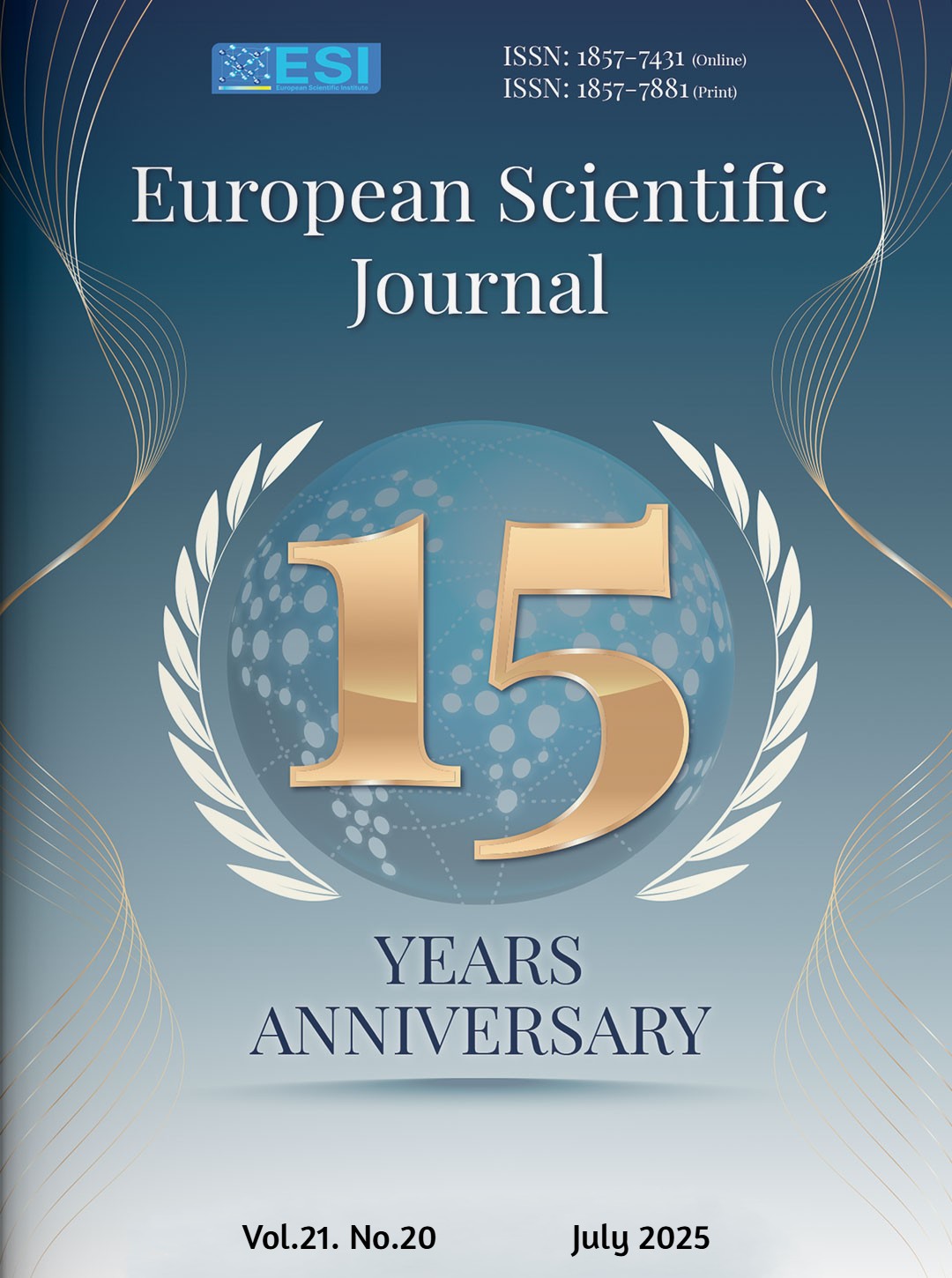English translation and validation of the Afterlife Belief Scale for British Muslims
Abstract
The purpose of the current study was to translate and validate the Afterlife Belief scale into the English language. To translate the scale, the forward-backward method was used. Through the committee approach, the English version of the scale was finalized. The English version of the Afterlife Belief Scale was administered to a sample of 300 British Muslims, with a mean age of 34.5 and a standard deviation of 3.5. Confirmatory factor analysis was conducted, and the results revealed excellent model fit indices with a two-factor structure. The original scale had a three-factor structure; however, in the current study, all items related to extinction-based afterlife Belief were found to have low loadings, so analysis was carried out on the remaining items. Keeping in view the results and feedback from participants and experts, the two-factor structure was finalized with excellent model fit indices (CFI, GFI, TLI, RMSEA, RMR). Alpha reliability indices of both subscales were excellent. Furthermore, in order to find the convergent and divergent validity evidence, the English version of the Afterlife Belief Scale, the Short Muslim Practice and Belief Scale, the Arabic Death Anxiety Scale, and the Penn Inventory of Scrupulosity Scale were administered to the 150 British Muslims. Correlation analysis provided evidence of convergent validity as afterlife beliefs were found to be correlated with death anxiety, scrupulosity, and religiosity. The findings support the English version of the Afterlife Belief Scale as a psychometrically sound instrument for assessing afterlife beliefs among British Muslims.
Downloads
Metrics
PlumX Statistics
References
2. Badawi, G. (2012). Muslim attitudes towards end-of-life decisions. The Journal of IMA, 43(3), 134.
3. Baines, J. R., & Dorman, P. F. (2024, June 24). Ancient Egyptian religion | History, Rituals, Gods, Beliefs, & Facts. Encyclopedia Britannica. https://www.britannica.com/topic/ancient-Egyptian-religion/The-world-of-the-dead
4. Baloch, F. (2023, April 2). Islamic beliefs about the afterlife. Al-Aleem Academy. https://alaleemacademy.com/islamic-beliefs-about-the-afterlife/. Retrieved on 20 May 2025.
5. Chaiwutikornwanich, A. (2015). Belief in the afterlife, death anxiety, and life satisfaction of Buddhists and Christians in Thailand: Comparisons between different religiosity. Social Indicators Research, 124, 1015-1032. https://doi.org/10.1007/s11205-014-0822-4
6. Choksi, M., & Amin, O. S. M. (2024). Ancient Mesopotamian beliefs in the afterlife. World History Encyclopedia. https://www.worldhistory.org/article/701/ancient-mesopotamian-beliefs-in-the-afterlife/.
7. Dalhat, Y. (2015). The Concept of al-Ruh (Soul) in Islam. International Journal of Education and Research, 3(8), 431-440.
8. Dastaghaib Shirazi, S. A. H. (2013, January 23). Barzakh (Purgatory) - The Stage Between this World and the Hereafter. Al-Islam.org. https://www.al-islam.org/hereafter-maad-sayyid-abdul-husayn-dastghaib-shirazi/barzakh-purgatory-stage-between-world-and
9. Ellis, L., & Wahab, E. A. (2013). Religiosity and fear of death: A theory-oriented review of the empirical literature. Review of Religious Research, 55(1), 149-189
10. Ghayas, S., & Batool, S. S. (2016). Urdu translation and validation of short Muslim practice and belief scale in Pakistan. The Spanish Journal of Psychology, 19, E22.https://doi.org/10.1017/sjp.2016.21
11. Ghayas, S., & Batool, S. S. (2017). Construction and validation of afterlife belief scale for Muslims. Journal of religion and health, 56, 861-87. https://doi.org/10.1007/s10943-016-0258-z
12. Ghayas, S., & Batool, S. S. (2021). Religious Orientation and Death Anxiety among Elderly Pakistani Muslims: Mediational Role of Afterlife Belief and Ego Integrity. Journal of Behavioural Sciences, 31(1).11-22.
13. Ghayas, S., Batool, S. S., & Adil, A. (2021). Relationship between religiosity and depression level of Pakistani elderly population: Mediational role of afterlife belief. Trends in Psychology, 29(1), 1-11.
14. Hadaway, C. K., Marler, P. L., & Chaves, M. (1993). What the polls don't show: A closer look at U.S. church attendance. American Sociological Review, 58(6), 741–752. https://doi.org/10.2307/2095948
15. Henrich, J., Heine, S. J., & Norenzayan, A. (2010). The weirdest people in the world? Behavioral and Brain Sciences, 33(2–3), 61–83. https://doi.org/10.1017/S0140525X0999152X
16. History timeline - The Association of British Muslims. (2016, June 23). The Association of British Muslims. https://aobm.org/learning/history-timeline/
17. Hussain, M. (2024, April 18). Two big challenges facing British Muslims. Dr Musharraf Hussain. https://www.musharrafhussain.com/two-big-challenges-facing-british-muslims/
18. IslamReligion.com. (2006). Belief in life after death. The Religion of Islam. https://www.islamreligion.com/articles/31/viewall/
19. Knott, K. (2018, March 26). British Muslims: A history. Crestresearch. https://crestresearch.ac.uk/resources/british-muslims-history/
20. Muslim Council of Britain. (2022, December 20). British Muslims | Muslim Council of Britain. https://mcb.org.uk/resources/british-muslims/
21. Muslim ibn al-Hajjaj. (n.d.). Sahih Muslim (Book 52, Hadith 6; Book 39, Hadith 6703). Retrieved from https://sunnah.com/muslim:2787
22. Noureen, S. Ghayas, S. Lewis, C A. (in press). Religiosity and scrupulosity: Examining the mediating role of afterlife belief in the context of Evolutionary Threat Assessment Systems Theory among Pakistani students. Mental Health, Religion and Culture.
23. Olatunji, B. O., Abramowitz, J. S., Williams, N. L., Connolly, K. M., &Lohr, J. M. (2007). Scrupulosity and obsessive-compulsive symptoms: Confirmatory factor analysis and validity of the Penn Inventory of Scrupulosity. Journal of anxiety disorders, 21(6), 771-787. http://dx.doi:10.1016/j.janxdis.2006.12.002
24. Quranic. (2024, March 8). Al-Akhirah | Meaning & Concept in Quran and Islam - Quranic Arabic For Busy People. Quranic Arabic for Busy People. https://www.getquranic.com/the-meaning-of-akhirah/
25. Six articles of faith (Sunni Islam) - Key beliefs in Islam - GCSE Religious Studies Revision - OCR - BBC Bitesize. (2024, May 15). BBC Bitesize. https://www.bbc.co.uk/bitesize/guides/zr4r97h/revision/1
26. The Holy Qur’an. (n.d.). Surah Al-Mu’minun [23:15–16]. Various Translations.
27. The Quran. (n.d.). Surah Al-Baqarah, 2:25. Retrieved from https://quran.com/2/25
28. The Quran. (n.d.). Surah An-Nisa, 4:42. Retrieved from https://quran.com/4/42
29. Tourangeau, R., & Yan, T. (2007). Sensitive questions in surveys. Psychological Bulletin, 133(5), 859–883. https://doi.org/10.1037/0033-2909.133.5.859
30. Volle, A. (2024, June 21). Afterlife | Definition, Belief, Religion, & Facts. Encyclopedia Britannica. https://www.britannica.com/topic/afterlife-religion
Copyright (c) 2025 Saba Ghayas, John B. Strait, Misbah Malik

This work is licensed under a Creative Commons Attribution 4.0 International License.








